  St. GérardMap Click on the map below to enlarge it. 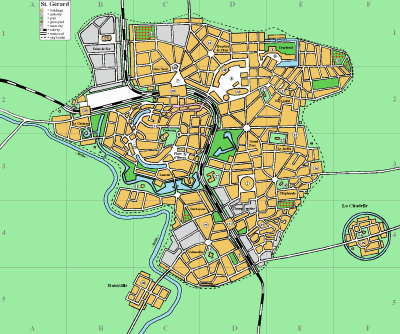 (opens in new window) Important places on the map are marked with a number, hereunder are these places with their number and the coordinates where they can be found on the map. 1. La Cathedrale Saint Gérard (C2/C3) The largest cathedral of Hiveria, dating from the 15th century and built in late gothic style. 2. Stade de Hiveria (D3) The most famous stadium of Hiveria, which is used for various purposes. Every week footbal matches, markets and bullfights are held, alternated with shows from the Cirque Acrobatique. 3. Canal Collignon (D4) The main office of Canal Collignon, the media company that owns most newspapers, radio and television channels in the country. 4. Palais Vitré (E1) The remains of Palais Vitré ("the Glass Palace"), which was partially destroyed during the Hiverian Revolution (1794). The western wing was lost and a large portion of the palace gardens was filled with buildings in the centuries after the revolution. These days it's a museum. 5. City hall (C3) The city hall of the municipality of St. Gérard. The original building dates from the 17th century but in 1983 the complex was expanded with a modern extension. 6. Place d’Hiveria (C3) One of the most well-known squares of St. Gérard. During the revolution the Hiverian monarchy ended on this spot when king Charles Concarneau and most of his family members were murdered here. 7. Place de la Gare (C2) The Railway Station Square with its many cafés and restaurants. 8. Place du Sénat (D2) The Senate Square, the biggest square of St. Gérard and the heart of the Hiverian government. In the center of the square stands an obelisk in commemoration of the Fourth Frilandic-Hiverian War (1881). 9. Place du Palais (E1) The former central pavilion of the Palais Vitré. 10. Le Sénat (D1/D2) The government buildings of Le Sénat, the Hiverian parliament. 11. Official residence of the president (C3) The official residence of the Hiverian president, dating from the beginning of the 19th century. 12. Tomb of Frederic Alvare (E3) The tomb of Frederic Alvare, the 19th century president, strategist and national hero who gained an almost absolute power in his three year reign. 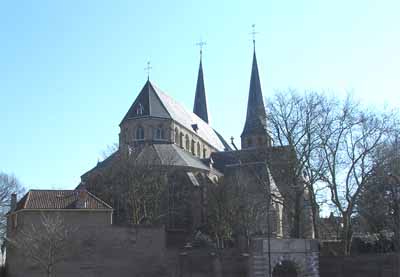 La Cathedrale Saint Gérard The Saint Peter Apostle church from 1893. 14. Monastère de Saint François d'Assise (D4) The 12th century Monastery of Saint Francis of Assisi, which is nowadays a church in the neighbourhood Valmoulin but used to be a monastery that lay outside the city. 15. Sacré Maria (E1/F1) The Holy Mary church. 16. l'Église de Garde (F4) The Church of the Guards in La Citadelle, named like that because it's construction was financed by the guardians of the city gates. 17. Al-Hajj mosque (D2) This mosque was built in 1988 as a gift from the president to the Islamic inhabitants of St. Gérard. 18. Sahaba mosque (E3) Financed by Yemenite backers and named after the companions of the prophet Muhammed. 19. Gare de l'Ouest (B2) Railway Station West, mainly used by commuters who work in the industrial area Usine de Fer. 20. Gare de Gaudin (C2) The Central Station of St. Gérard, which is named after Guillaume Gaudin, the first Hiverian president. 21. Gare de Champmétier (D4) Railway Station Champmétier, which is so dangerous in the evening that after dark most citizens take the bus when they have to be in the southern part of the city. 22. Supreme Court (D2) The Hiverian Supreme Court, which is situated in an oval building that seems to consist of sheer glass. Recommended for those who appreciate modern building styles. 23. Market (B3/C3) The market was created by covering up a portion of the old city canal. 24. Château Gournay (B2/B3) Castle Gournay was once property of the noble family Gournay but was disowned during the revolution and successively used as horse stables, storage room, ministers residence and nowadays as a museum. 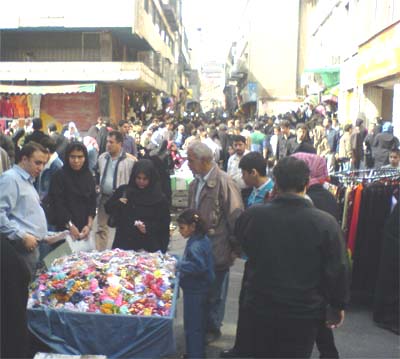 The market in Bayt Jadid The university of St. Gérard. 26. Football stadium (B1) The stadium of Rapide St. Gérard, one of the most popular national clubs. 27. Hospital (D3) The Hôpital de Saint Camille. 28. Rouxville (C5) The village of Rouxville is part of the municipality of St. Gérard and was built in 1971 to meet the increasing demand for housing. The village is named after its designer; architect Lucas Roux. 29. La Citadelle (F4) This little village was originally meant to be a defensive fortification but lack of money halted that project, after which a settlement came into being on that spot (see the history at the bottom of this page for more information). 30. Main office Groupe Devereux (C1/C2) The main office of the bank Groupe Devereux, which was built in deconstructivist style though critics mainly compare it to a wrinkled piece of carpet. 31. Rue de Tanneurs (C2) The Rue de Tanneurs is known for its many good restaurants an is therefore a recommendation for connoisseurs. 32. Boulevard Jaquin (E2/E3) The longest boulevard in the city, named after former president Maurice Jaquin. 33. Bayt Jadid (E2) The Arab neighbourhood Bayt Jadid ('New House'), where many Islamic immigrants moved in during the 80's and 90's. The original name of this neighborhood was Quartier Tonnelier ("Cooper's District"), but in 2003 a new Arabic name was chosen in a referendum. People who like to get acquainted with other cultures will not be disappointed here. 34. Quartier de l’Etat (D1) Here many civil servants live and most government buildings can also be found here. The architecture of this neighbourhood is characterized by austere, functional buildings. 35. Champmétier (D4/E4) Champmétier is a so-called "rough area"; it is plagued by poverty and crime but is also known for its rich cultural diversity and dazzling music scene. Tourists are recommended to only enter this neighbourhood with an experienced guide. 36. Prison (E3) The Pénitentiaire Fournier is named after Alfredo Fournier, former minister of Justice. 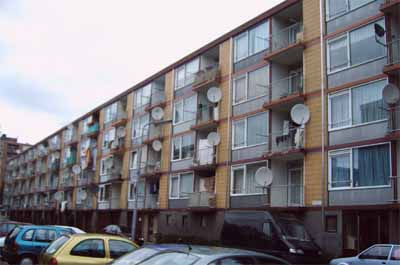 Apartments in Champmétier Neighbourhoods Hereunder you can find a list of all neighbourhoods in St. Gérard with behind it their coordinates on the map. The map on this page only shows the main roads. Barbacane (C3/C4) Bayt Jadid (E2) Bois Nord (C1/C2) Champmétier (D4/E4) Courderoi (E1) Le Château (B2/B3) l’Esplanade (E3) Frobourg (C2/C3) Grand Parc (D2/D3) Le Jardin (E3) Lunette (C3) Quartier de l’Etat (D1/D2) Usine de Fer (B1/B2) Valmoulin (C4/D4) History Ancient history In ancient times modern St. Gérard was a village named Froburg, which laid in the Frilandic shire of Hamulga ("Stone shire"). The current city center is therefore still called Frobourg and under the Rue de Tanneurs remains of farms from that period have been found. In 1078 a Norman army led by Guy le Breton invaded Friland; the east of Hamulga, these days called Heunia, was overrun. In Froburg Guy le Breton destroyed the temple of the goddess Fro and founded a church on that spot, which he named after the holy Gérard Etretat, a saint who was beheaded by Frilandic warriors during a failed conversion attempt and was thereafter supposedly carried to heaven by angels. The original population of Froburg was converted to Christianity and those who refused were killed or expelled. Froburg was called St. Gérard from that time on and in the same year it became the capital of the new duchy of Hiveria. In the years thereafter many Norman citizens from France and the British isles settled there. Because the battle against the Frilanders raged on, St. Gérard was equipped with an earth wall and moat. War and religious tensions In 1139 Hiveria became an independant country with Lothaire d’Alençon as its first king. St. Gérard grew into a large city and continued blossoming until the 14th century, after which the outbreak of the plague in Europe led to great poverty due to the trade stop. Just when it started to get better with St. Gérard, the Third Frilandic-Hiverian War broke out. The conflict ended in disaster for Hiveria and in 1448 the Frilandic king Bloþwulf appeared before the gates. Southwest of the city a battery of cannons was placed to wipe all of St. Gérard off the map, though the destruction of the city was prevented at the very last moment when king Anfroi Concarneau signed the peace of Liousville. In the 15th century the church of St. Gérard burned down to the ground after a lightning strike. In an attempt to restore national pride, it was decided to replace the burned church with a great cathedral; the current Cathedrale Saint Gérard. Despite this boost for the city's religious life, the 16th century Reformation caused much unrest; Protestants, Jews and other non-Catholics were mercilessly procecuted. New defensive fortifications were also built to counter threats from the outside. 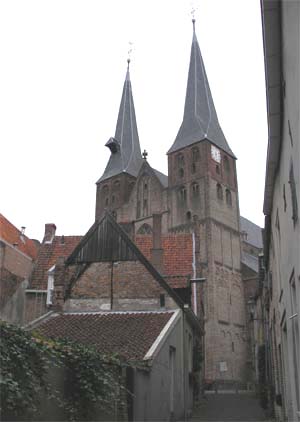 De cathedraal, gezien vanuit het zuiden To be able to keep the city under better control in the future as well as improving its defence, it was decided to build a star-shaped citadel with bastions and heavy artillery to the southeast of the city. Between the existing buildings and the citadel a new neighbourhood would be constructed. However, the planned expansion of the city was cancelled due to a stagnate population growth. The half-finished citadel was rendered useless because of this and the project was also lacking money. Therefore it was made into a barracks and only equipped with a simple, round moat with earth wall. Some decades later "the Citadel" was released for habitation purposes, after which it grew into a small village with the appearance of a fortress; modern La Citadelle. Revolution During the 18th century many slaves from the Hiverian colonies were put to work on the fields around St. Gérard. In that time an estimated 15% of the population consisted of slaves, especially from Kumanga. In 1794 the Hiverian revolution broke out; in St. Gérard there was heavy fighting between the rebels and government troops, which took hundreds of casualties. King Charles Concarneau and his family were dragged from the Palais Vitré and brought to the square in front of the city hall, where they were lynched by an angry mob. Most other nobles in the city were also murdered. Both castles of St. Gérard were besieged; Château Lisieux, which stood on the place of the currect Sahaba mosque, was destroyed and Château Gournay, which still exists, was taken after the owners had fled using an underground tunnel. Palais Vitré, the royal palace, was also partially destroyed. The royalist troops retreated and out of revenge they set fire to the city; because of this, most of the southwestern part of St. Gérard, on the other side of the Brille, was lost. After the death of the king the Conceil Révolutionnaire (Revolutionary Council) took over power in Hiveria and built the current Senate building in the northeast of St. Gérard. Renewal In 1840 Heunia, St. Gérard and La Rade were connected with a railroad. The railway was constructed on the old earthen defence wall and therefore runs around the old city center like a loop. On April 18 the first locomotive of the Hiverian railway company Chemins de Fer Hiverienne (CFH) arrived on the station of St. Gérard. In 1880 Frederic Alvare became president of Hiveria. Not long after his installation he managed to seize all power to himself and the Conceil Révolutionnaire was degraded into a puppet club. The rebuilding of the burned down southwestern part of the city was halted and he ordered the already restored buildings to be demolished again because they ruined the view from his official residence. After Alvare's death in 1883 Hiveria became a democracy again. During the 19th century it was decided to follow the example of the Parisian city architect Georges-Eugène Hausmann and large parts of St. Gérard were demolished and rebuilt in modern style. Broad boulevards were constructed which joined into star-shaped squares. Because many houses had to be broken down for this, it led to a big uproar. Slavery and immigration In 1884 there was more unrest after rumours that the senate wanted to abolish slavery. Streetfights took place between supporters and opponents and the many African slaves that were put to work on farms around St. Gérard went on strike. Eventually president Jaquin decided to abolish slavery, which turned all slaves in the country into free citizens. From the 70's onward large numbers of immigrants came to Hiveria, of which many settled in the big cities. In St. Gérard the majority of the population consists of immigrants and especially the neighbourhoods Champmétier, l'Esplanade and Bayt Jadid are known for their multicultural character. On November 6, 2005 two terrorist attacks were made on a police station and a church in St. Gérard. Because the culprits turned out to be radical muslims, unrest emerged in the city between the several population groups. After some weeks of tensions the mayor managed to start a dialogue and calm things down. 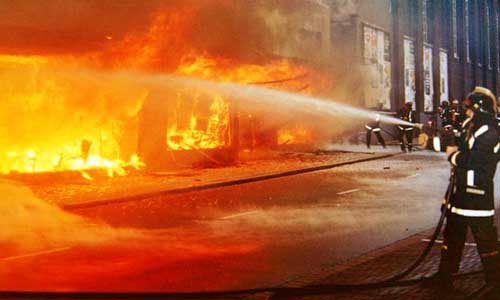 The attacks of 2005 During the Fifth Frilandic-Hiverian War in February 2009 St. Gérard was spared. The only incident took place on February 19, when Frilandic fighters flew over the city and destroyed a number of radar stations. A large scale air raid never took place though, because two days later an armistice was signed. Nowadays the news is mainly dominated by the tensions in rough areas like Champmétier, where the situation has gotten so out of hand that the gendarme only patrols there on foot, since their cars are being stolen on a regular basis.  |